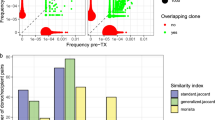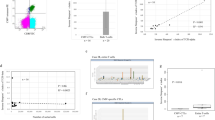Abstract
Restoration of T cell repertoire diversity after allogeneic bone marrow transplantation (allo-BMT) is crucial for immune recovery. T cell diversity is produced by rearrangements of germline gene segments (V (D) and J) of the T cell receptor (TCR) α and β chains, and selection induced by binding of TCRs to MHC-peptide complexes. Multiple measures were proposed for this diversity. We here focus on the V-gene usage and the CDR3 sequences of the beta chain. We compared multiple T cell repertoires to follow T cell repertoire changes post-allo-BMT in HLA-matched related donor and recipient pairs. Our analyses of the differences between donor and recipient complementarity determining region 3 (CDR3) beta composition and V-gene profile show that the CDR3 sequence composition does not change during restoration, implying its dependence on the HLA typing. In contrast, V-gene usage followed a time-dependent pattern, initially following the donor profile and then shifting back to the recipients' profile. The final long-term repertoire was more similar to that of the recipient's original one than the donor’s; some recipients converged within months, while others took multiple years. Based on the results of our analyses, we propose that donor-recipient V-gene distribution differences may serve as clinical biomarkers for monitoring immune recovery.




Similar content being viewed by others
Data Availability
The datasets generated and/or analyzed during the current study are available in the Adaptive Biotechnologies database (Seattle, WA; https://clients.adaptivebiotech.com).
References
Bassing CH, Swat W, Alt FW (2002) The mechanism and regulation of chromosomal V ( D ) J Recombination. Cell 109:45–55
Benichou J, Ben-Hamo R, Louzoun Y, Efroni S (2011) Rep-Seq : uncovering the immunological repertoire through next-generation sequencing. Immunology 135(3):183–191
Benichou JIC, van Heijst JWJ, Glanville J, Louzoun Y (2017) Converging evolution leads to near maximal junction diversity through parallel mechanisms in B and T cell receptors. Phys Biol 14(4):5003
Benjamini Y, Drai D, Elmer G, Kafkafi N, Golani I (2001) Controlling the false discovery rate in behavior genetics research. Behav Brain Res 125(1–2):279–284
Borg I, Groenen P (2005) Modern Multidimensional Scaling: theory and applications, 2nd edn. Springer-Verlag, New York, pp 207–212
Britanova OV, Putintseva EV, Shugay M, Merzlyak EM, Turchaninova MA, Staroverov DB, Bolotin DA, Lukyanov S, Bogdanova EA, Mamedov IZ, Lebedev YB, Chudakov DM (2014) Age-related decrease in TCR repertoire diversity measured with deep and normalized sequence profiling. J Immunol 192(6):2689–2698
Buhler S, Bettens F, Dantin C, Ferrari-Lacraz S, Ansari M, Mamez AC, Masouridi-Levrat S, Chalandon Y, Villard J (2019) Genetic T-cell receptor diversity at 1 year following allogeneic hematopoietic stem cell transplantation. Leukemia 34(5):1422–1432
Burrows SR, Silins SL, Moss DJ, Khanna R, Misko IS, Argaet VP (1995) T cell receptor repertoire for a viral epitope in humans is diversified by tolerance to a background major histocompatibility complex antigen. J Exp Med 182(6):1703–1715
Cells HCDT, Luo W, Ma L, Wen Q, Zhou M, Wang X (2009) Analysis of the conservation of T cell receptor alpha and beta chain variable regions gene in pp65 peptide-specific (2):105–110
Chaudhry MS, Velardi E, Malard F, Van Den Brink MRM (2019) Immune reconstitution after allogeneic hematopoietic stem cell transplantation: time to T up the thymus. J Immunology 198:40–46
Cieri N, Oliveira G, Greco R, Forcato M, Taccioli C, Cianciotti B, Valtolina V, Noviello M, Vago L, Bondanza A, Lunghi F, Marktel S, Bellio L, Bordignon C, Bicciato S, Peccatori J, Ciceri F, Bonini C (2015) Generation of human memory stem T cells after haploidentical T-replete hematopoietic stem cell transplantation. Blood 125(18):2865–2874
Dean J, Emerson RO, Vignali M, Sherwood AM, Rieder MJ, Carlson CS, Robins HS (2015) Annotation of pseudogenic gene segments by massively parallel sequencing of rearranged lymphocyte receptor loci. Genome Medicine 123(7):1–8
Dickinson AM (2016) Immune reconstitution after allogeneic hematopoietic stem cell transplantation. Front Immunol 17(7):507
Douek DC, Vescio RA, Betts MR, Brenchley JM, Hill BJ, Zhang L, Berenson JR, Collins RH, Koup RA (2000) Assessment of thymic output in adults after haematopoietic stem-cell transplantation and prediction of T-cell reconstitution. Lancet 355:1875–1881
Elhanati Y, Sethna Z, Callan CG, Mora T, Walczak AM (2018) Predicting the spectrum of TCR repertoire sharing with a data-driven model of recombination. Immunol Rev 284(1):167–179
Fallen PR, Mcgreavey L, Madrigal JA, Potter M, Ethell M, Prentice HG, Travers PJ (2003) Lymphoid reconstitution factors affecting reconstitution of the T cell compartment in allogeneic haematopoietic cell transplant recipients. Bone Marrow Transplant 32(10):1001–1014
Gauthier S, Moutuou MM, Daudelin F, Leboeuf D, Guimond M (2018) IL-7 is the limiting homeostatic factor that constrains homeostatic proliferation of CD8 + T cells after allogeneic stem cell transplantation and graft-versus-host disease. Biol Blood Marrow Transplant 25(4):648–655
Gerlinger M, Quezada SA, Peggs KS, Furness AJ, Fisher R, Marafioti T, Swanton C (2013) Ultra-deep T cell receptor sequencing reveals the complexity and intratumour heterogeneity of T cell clones in renal cell carcinomas. J Pathol 231(4):424–432
Heather JM, Ismail M, Oakes T, Chain B (2018) High-throughput sequencing of the T-cell receptor repertoire: pitfalls and opportunities. Brief Bioinform 19(4):554–565
Izraelson M, Nakonechnaya TO, Moltedo B, Egorov ES, Kasatskaya SA, Putintseva EV, Mamedov IZ, Staroverov DB, Shemiakina II, Zakharova MY, Davydov AN, Bolotin DA, Shugay M, Chudakov DM, Rudensky AY, Britanova OV (2018) Comparative analysis of murine T-cell receptor repertoires. Immunology 153(2):133–144
Johnson SC (1967) Hierarchical clustering schemes. Psychometrika 32:241–254
Kanakry CG, Coffey DG, Towlerton AM, Vulic A, Storer BE, Chou J, Yeung CC, Gocke CD, Robins HS, O’Donnell PV, Luznik L, Warren EH (2016) Origin and evolution of the T cell repertoire after posttransplantation cyclophosphamide. JCI Insight 1(5):e86252
Kanakry CG, O'Donnell PV, Furlong T, de Lima MJ, Wei W, Medeot M, Mielcarek M, Champlin RE, Jones RJ, Thall PF, Andersson BS, Luznik L (2014) Multi-institutional study of post-transplantation cyclophosphamide as single-agent graft-versus-host disease prophylaxis after allogeneic bone marrow transplantation using myeloablative busulfan and fludarabine conditioning. J Clin Oncol 32(31):3497–3505
Koning D, Costa AI, Hoof I, Miles JJ, Nanlohy NM, Ladell K, Matthews KK, Venturi V, Schellens IM, Borghans JA, Kesmir C, Price DA, van Baarle D (2012) CD8+ TCR repertoire formation is guided primarily by the peptide component of the antigenic complex. J Immunol 190(3):931–939
Koning CD, Nierkens S, Boelens JJ (2016) Strategies before, during, and after hematopoietic cell transplantation to improve T-cell immune reconstitution. Blood 128(23):2607–2616
Krenger W, Blazar BR, Holla GA (2011) Thymic T-cell development in allogeneic stem cell transplantation. Blood 117(25):6768–6777
Kullback S, Leibler RA (1951) On Information and Sufficiency. Ann Math Stat 22(1):79–86
Levenshtein VI (1966) Binary codes capable of correcting deletions, insertions, and reversals. Sov Phys Dokl 10(8):707–710
Lissina A, Chakrabarti LA, Takiguchi M, Appay V (2016) TCR clonotypes: molecular determinants of T-cell efficacy against HIV. Curr Opin Virol 16:77–85. https://doi.org/10.1016/j.coviro.2016.01.017
Lynch HE, Goldberg GL, Chidgey A, Van Den Brink MRM, Boyd R, Sempowski GD (2009) Thymic involution and immune reconstitution. Cell 30(7):366–373. https://doi.org/10.1016/j.it.2009.04.003
Madi A, Shifrut E, Reich-Zeliger S, Gal H, Best K, Ndifon W, Chain B, Cohen IR, Friedman N (2014) T-cell receptor repertoires share a restricted set of public and abundant CDR3 sequences that are associated with self-related immunity. Genome Res 24(10):1603–1612
Mamedov IZ, Britanova OV, Bolotin DA, Chkalina AV, Staroverov DB, Zvyagin IV, Kotlobay AA, Turchaninova MA, Fedorenko DA, Novik AA, Sharonov GV, Lukyanov S, Chudakov DM, Lebedev YB (2011) Quantitative tracking of T cell clones after haematopoietic stem cell transplantation. EMBO Mol Med 3(4):201–207
Meier JA, Haque M, Fawaz M, Abdeen H, Coffey D, Towlerton A, Abdeen A, Toor A, Warren E, Reed J, Kanakry CG, Keating A, Luznik L, Toor AA (2019) Biology of blood and T cell repertoire evolution after allogeneic bone marrow transplantation: an organizational perspective. Biol Blood Marrow Transplant 25(5):868–882
Muraro PA, Robins H, Malhotra S, Howell M, Phippard D, Desmarais C, de Paula Alves Sousa A, Griffith LM, Lim N, Nash RA, Turka LA, (2014) T cell repertoire following autologous stem cell transplantation for multiple sclerosis. J Clin Invest 124(3):1168–1172
Nakano N (1991) T cell receptor V gene usage of islet beta cell-reactive T cells is not restricted in non-obese diabetic mice. J Exp Med 173(5):1091–1097
Nakasone H, Tanaka Y, Yamazaki R, Terasako K, Sato M, Sakamoto K, Kanda Y (2014) Single-cell T-cell receptor-β analysis of HLA-A*2402-restricted CMV- pp65-specific cytotoxic T-cells in allogeneic hematopoietic SCT. Bone Marrow Transplant 49(1):87–94
Navarro G (2001) A guided tour to approximate string matching. ACM Comput Surv 33(1):31–88
Ogonek J, Kralj Juric M, Ghimire S, Varanasi PR, Holler E, Greinix H, Weissinger E (2016) Immune reconstitution after allogeneic hematopoietic stem cell transplantation. Front Immunol 17(7):507
Pogorelyy MV, Fedorova AD, McLaren JE, Ladell K, Bagaev DV, Eliseev AV, Mikelov AI, Koneva AE, Zvyagin IV, Price DA, Chudakov DM, Shugay M (2018) Exploring the pre-immune landscape of antigen-specific T Cells. Genome Medicine 10(1):68–82
Ringhoffer S, Rojewski M, Döhner H, Bunjes D, Ringhoffer M (2013) T-cell reconstitution after allogeneic stem cell transplantation : assessment by measurement of the sjTREC / β TREC ratio and thymic naïve T cells. Haematologica 98(10):1600–1608
Robins H (2010) Overlap and effective size of the human CD8+ T-cell receptor repertoire. Sci Transl Med 2(47):1–9
Robinson TM, O’Donnell PV, Fuchs EJ, Luznik L (2016) Haploidentical bone marrow and stem cell transplantation: experience with post-transplantation cyclophosphamide. Semin Hematol 53(2):90–97
Rubelt F, Bolen CR, Mcguire HM, Heiden JA, Vander GMD, Levin M, Davis MM (2016) Individual heritable differences result in unique cell lymphocyte receptor repertoires of naïve and antigen-experienced cells. Nat Commun 6:1–12
Sakai R, Kinouchi T, Kawamoto S, Dana MR, Hamamoto T, Tsuru T, Yamagami S (2002) Construction of human corneal endothelial cDNA library and identification of novel active genes. Invest Ophthalmol Vis Sci 43(6):1749–1756
Scheckelhoff MR, Deepe GS (2006) Pulmonary V beta 4+ T cells from Histoplasma capsulatum-infected mice respond to a homologue of Sec31 that confers a protective response. J Infect Dis 193(6):888–897
Schrama D, Ritter C, Becker JC (2017) T cell receptor repertoire usage in cancer as a surrogate marker for immune responses. Seminars in ImmunopathologyImmunopathol 39:255–268
Shugay M, Bolotin DA, Putintseva EV, Pogorelyy MV, Mamedov IZ, Chudakov DM (2013) Huge overlap of individual TCR beta repertoires. Front Immunol 4:466
Toubert A, Glauzy S, Douay C, Clave E (2012) Thymus and immune reconstitution after allogeneic hematopoietic stem cell transplantation in humans: never say. Tissue Antigens 79(2):83–89
Turner SJ, Kedzierska K, La Gruta NL, Webby R, Doherty PC (2004) Characterization of CD8+ T cell repertoire diversity and persistence in the influenza a virus model of localized, transient infection. Semin Immunol 16(3):179–184
Yew PY, Alachkar H, Yamaguchi R, Kiyotani K, Fang H, Yap KL, Liu HT, Wickrema A, Artz A, van Besien K, Imoto S, Miyano S, Bishop MR, Stock W, Nakamura Y (2015) Quantitative characterization of T-cell repertoire in allogeneic hematopoietic stem cell transplant recipients. Bone Marrow Transplant 50(9):1227–1234
Zvyagin IV, Pogorelyy MV, Ivanova ME, Komech EA, Shugay M, Bolotin DA, Shelenkov AA, Kurnosov AA, Staroverov DB, Chudakov DM, Lebedev YB, Mamedov IZ (2014) Distinctive properties of identical twins TCR repertoires revealed by high-throughput sequencing. Proc Natl Acad Sci U S A 111(16):5980–5985
Author information
Authors and Affiliations
Contributions
SD designed the formalism and implemented it; NTM collected the data and wrote the manuscript; AR and AAK collected the data and prepared it; SE supervised the work; YL supervised the work and wrote the manuscript.
Corresponding author
Ethics declarations
Conflict of interests
The authors declare that they have no competing interests.
Additional information
Publisher’s Note
Springer Nature remains neutral with regard to jurisdictional claims in published maps and institutional affiliations.
Supplementary Information
Below is the link to the electronic supplementary material.
Rights and permissions
About this article
Cite this article
Tickotsky-Moskovitz, N., Louzoun, Y., Dvorkin, S. et al. CDR3 and V genes show distinct reconstitution patterns in T cell repertoire post-allogeneic bone marrow transplantation. Immunogenetics 73, 163–173 (2021). https://doi.org/10.1007/s00251-020-01200-7
Received:
Accepted:
Published:
Issue Date:
DOI: https://doi.org/10.1007/s00251-020-01200-7




